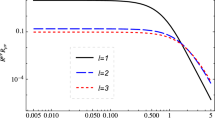Abstract
The first part of this paper examines conditions in accord with Einstein's criterion of regularity on the field solutions everywhere that would correspond to the existence of a black hole star, following from solutions of his (nonvacuum) field equations. ‘Black hole’ is defined here as a star whose matter is so condensed as to correspond to a complete family of spatially closed geodesics. The condition imposed is that the angular momentum of a test body in each of the closed geodesics is a constant of the motion. The second part of the paper examines the implications in the problem of the condensed star of a generalized (factorized) version of the metrical field equations, discovered earlier by the author. It is found that in general relativity stars should naturally pulsate, and in its succeeding cycles the gravitational radius of the star is attenuated by a factor exp(−0.349T), where T is the pulsation period. Conditions are discussed for the possibility that the (relatively) regular emissions of radiation from a pulsar may be dynamically rooted in a (smaller) part of the pulsation cycle when the star is out of the black hole state (less dense → open geodesics)—when radiation would be emitted to the outside world—and the (greater) part of the cycle when it is in the black hole state (more dense → closed geodesics)—when radiation would not be emitted.
Similar content being viewed by others
References
R. Adler, M. Bazin, and M. Schiffer,Introduction to General Relativity (McGraw-Hill, 1975), Second edition, chapter 6, 7.
A. Einstein, “Autobiographical Notes,” inAlbert Einstein-Philosopher-Scientist, P. A. Schilpp, ed. (Library of Living Philosophers, 1949), p. 81.
A. Einstein and N. Rosen,Phys. Rev. 48, 73 (1935).
S. W. Hawking and G. F. R. Ellis,The Large Scale Structure of Space-Time (Cambridge, 1973), p. 365.
C. Lanczos,The Variational Principles of Mechanics (Toronto, 1966), Third edition.
M. Sachs, “On the Nature of Light and the Problem of Matter,” inContemporary Research in the Foundations and Philosophy of Quantum Theory, C. A. Hooker, ed. (Reidel, 1973), p. 346.
M. Sachs,Ann. Inst. H. Poincaré 28, 399 (1978);Eighth Int. Conference on General Relativity and Gravitation (Waterloo, 1977), p. 309;
M. Sachs,Int. Jour. Theoret. Phys. 14, 115 (1975).
M. Sachs,Nuovo Cimento 47, 759 (1967);Nuovo Cimento 55B, 199 (1968).
M. Sachs,Nuovo Cimento 66B, 137 (1970).
P. A. M. Dirac,General Theory of Relativity (Wiley, 1975), p. 32.
Author information
Authors and Affiliations
Rights and permissions
About this article
Cite this article
Sachs, M. A pulsar model from an oscillating black hole. Found Phys 12, 689–708 (1982). https://doi.org/10.1007/BF00729806
Received:
Issue Date:
DOI: https://doi.org/10.1007/BF00729806




